The PP6 phosphatase regulates ABI5 phosphorylation and abscisic acid signaling in Arabidopsis
- PMID: 23404889
- PMCID: PMC3608775
- DOI: 10.1105/tpc.112.105767
The PP6 phosphatase regulates ABI5 phosphorylation and abscisic acid signaling in Arabidopsis
Abstract
The basic Leucine zipper transcription factor ABSCISIC ACID INSENSITIVE5 (ABI5) is a key regulator of abscisic acid (ABA)-mediated seed germination and postgermination seedling growth. While a family of SUCROSE NONFERMENTING1-related protein kinase2s (SnRK2s) is responsible for ABA-induced phosphorylation and stabilization of ABI5, the phosphatase(s) responsible for dephosphorylating ABI5 is still unknown. Here, we demonstrate that mutations in FyPP1 (for Phytochrome-associated serine/threonine protein phosphatase1) and FyPP3, two homologous genes encoding the catalytic subunits of Ser/Thr PROTEIN PHOSPHATASE6 (PP6), cause an ABA hypersensitive phenotype in Arabidopsis thaliana, including ABA-mediated inhibition of seed germination and seedling growth. Conversely, overexpression of FyPP causes reduced sensitivity to ABA. The ABA hypersensitive phenotype of FyPP loss-of-function mutants is ABI5 dependent, and the amount of phosphorylated and total ABI5 proteins inversely correlates with the levels of FyPP proteins. Moreover, FyPP proteins physically interact with ABI5 in vitro and in vivo, and the strength of the interaction depends on the ABI5 phosphorylation status. In vitro phosphorylation assays show that FyPP proteins directly dephosphorylate ABI5. Furthermore, genetic and biochemical assays show that FyPP proteins act antagonistically with SnRK2 kinases to regulate ABI5 phosphorylation and ABA responses. Thus, Arabidopsis PP6 phosphatase regulates ABA signaling through dephosphorylation and destabilization of ABI5.
Figures
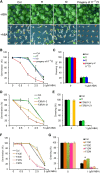
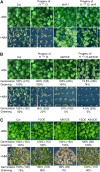
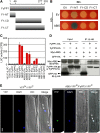
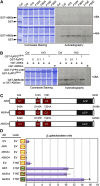
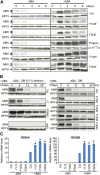


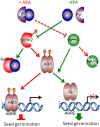
Similar articles
-
Arabidopsis RAV1 transcription factor, phosphorylated by SnRK2 kinases, regulates the expression of ABI3, ABI4, and ABI5 during seed germination and early seedling development.Plant J. 2014 Nov;80(4):654-68. doi: 10.1111/tpj.12670. Plant J. 2014. PMID: 25231920
-
TAP46 plays a positive role in the ABSCISIC ACID INSENSITIVE5-regulated gene expression in Arabidopsis.Plant Physiol. 2014 Feb;164(2):721-34. doi: 10.1104/pp.113.233684. Epub 2013 Dec 19. Plant Physiol. 2014. PMID: 24357600 Free PMC article.
-
BRASSINOSTEROID INSENSITIVE2 interacts with ABSCISIC ACID INSENSITIVE5 to mediate the antagonism of brassinosteroids to abscisic acid during seed germination in Arabidopsis.Plant Cell. 2014 Nov;26(11):4394-408. doi: 10.1105/tpc.114.130849. Epub 2014 Nov 21. Plant Cell. 2014. PMID: 25415975 Free PMC article.
-
Updates on the Role of ABSCISIC ACID INSENSITIVE 5 (ABI5) and ABSCISIC ACID-RESPONSIVE ELEMENT BINDING FACTORs (ABFs) in ABA Signaling in Different Developmental Stages in Plants.Cells. 2021 Aug 5;10(8):1996. doi: 10.3390/cells10081996. Cells. 2021. PMID: 34440762 Free PMC article. Review.
-
ABSCISIC ACID INSENSITIVE 5 mediates light-ABA/gibberellin crosstalk networks during seed germination.J Exp Bot. 2022 Aug 11;73(14):4674-4682. doi: 10.1093/jxb/erac200. J Exp Bot. 2022. PMID: 35522989 Review.
Cited by
-
Dynamics of Protein Phosphorylation during Arabidopsis Seed Germination.Int J Mol Sci. 2022 Jun 24;23(13):7059. doi: 10.3390/ijms23137059. Int J Mol Sci. 2022. PMID: 35806063 Free PMC article.
-
Misregulation of ER-Golgi Vesicle Transport Induces ER Stress and Affects Seed Vigor and Stress Response.Front Plant Sci. 2018 May 18;9:658. doi: 10.3389/fpls.2018.00658. eCollection 2018. Front Plant Sci. 2018. PMID: 29868102 Free PMC article.
-
HISTONE DEACETYLASE 9 transduces heat signal in plant cells.Proc Natl Acad Sci U S A. 2022 Nov 8;119(45):e2206846119. doi: 10.1073/pnas.2206846119. Epub 2022 Nov 2. Proc Natl Acad Sci U S A. 2022. PMID: 36322735 Free PMC article.
-
CycC1;1 negatively modulates ABA signaling by interacting with and inhibiting ABI5 during seed germination.Plant Physiol. 2022 Nov 28;190(4):2812-2827. doi: 10.1093/plphys/kiac456. Plant Physiol. 2022. PMID: 36173345 Free PMC article.
-
AGAMOUS-LIKE67 Cooperates with the Histone Mark Reader EBS to Modulate Seed Germination under High Temperature.Plant Physiol. 2020 Sep;184(1):529-545. doi: 10.1104/pp.20.00056. Epub 2020 Jun 23. Plant Physiol. 2020. PMID: 32576643 Free PMC article.
References
-
- Bracha-Drori K., Shichrur K., Katz A., Oliva M., Angelovici R., Yalovsky S., Ohad N. (2004). Detection of protein-protein interactions in plants using bimolecular fluorescence complementation. Plant J. 40: 419–427 - PubMed
-
- Busk P.K., Pagès M. (1998). Regulation of abscisic acid-induced transcription. Plant Mol. Biol. 37: 425–435 - PubMed
Publication types
MeSH terms
Substances
Grants and funding
LinkOut - more resources
Full Text Sources
Other Literature Sources
Molecular Biology Databases

